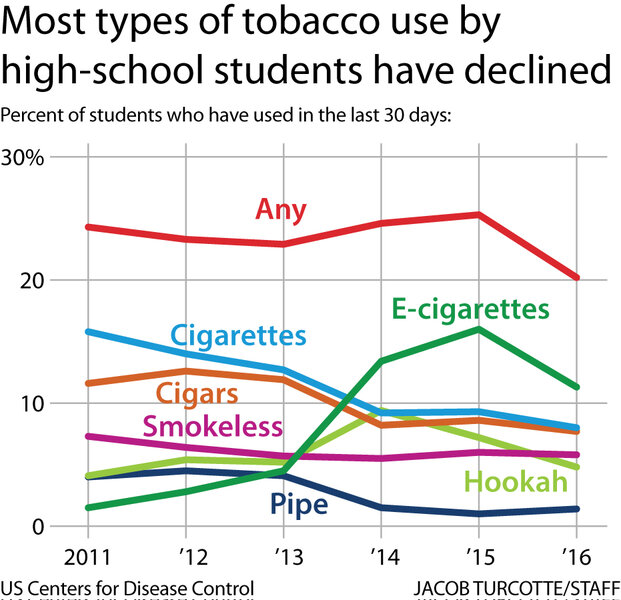US teen tobacco use declines
Loading...
America’s youth is turning its back on tobacco.
According to a study recently published by the Centers for Disease Control and Prevention (CDC), cigarette smoking among US high school students is at an all-time low. One in 5 US high school students in 2016 reported using a tobacco product within the past 30 days, an improvement from 1 in 4 students just one year before.
“These findings reinforce the importance of continuing to implement the evidence-based strategies that we know work to reduce all forms of tobacco product use, including e-cigarettes, among our nation’s youth,” says Brian King, of the CDC’s Office on Smoking and Health and senior author of the study.
And it’s not just tobacco: Drug use among US teens is down across the board. The National Institute on Drug Abuse has published annual reports on US teens’ drug use since 1996, and the 2016 survey shows the lowest rates of prescription drug, illicit drug, and alcohol use. Marijuana use remained “mostly steady.”
“It is encouraging to see more young people making healthy choices not to use illicit substances,” says former National Drug Control Policy Director Michael Botticelli.
All individual forms of tobacco such as cigarettes, e-cigarettes, cigars, hookahs, and smokeless tobacco saw declines in usage in 2016, except for a slight uptick in pipe tobacco use.
Experts are especially encouraged by the first decline in e-cigarettes, the most popular tobacco product among teens. In 2016, 11.3 percent of high school students reported using electronic cigarettes, down from 16 percent in 2015.
Dr. King says adaptation is key to the decline of e-cigarettes.
“We have over a half-century of science demonstrating the harms of tobacco use and what works best to prevent it,” says King. “E-cigarettes are the most commonly used tobacco product among our nation’s youth, and it’s critical that our proven strategies are modernized to keep pace with the changing tobacco product landscape.”
Researchers note the importance of public media campaigns. In 2014, the Federal Drug Administration (FDA) launched “The Real Cost,” its first public awareness campaign on the dangers of smoking, with the goal of breaking a plateau in youth smoking rates, and it has had a notable effect. Within the first seven months of the campaign, 90 percent of US youth reported seeing a related ad, and an analysis of the campaign’s success in January projects that the campaign prevented 350,000 youths from smoking.
Public health advocates are motivated by the recent figures, but say there is more work to be done.
“Every day in the US, more than 2,500 youth under the age of 18 smoke their first cigarette and more than 400 youth become daily cigarette smokers,” FDA Commissioner Scott Gottlieb said in a recent press release. “[I]t is critical that we work to ensure this downward trend continues over the long term across all tobacco products.”
The authors of the CDC study recommend increasing the price of tobacco products, eliminating tobacco flavoring, and including e-cigarettes in smoke-free policies. Raising the minimum age for the sale of tobacco products from 18 to 21 would decrease rates further.
Robin Koval, chief executive officer and president of Truth Initiative, a nonprofit focused on reducing tobacco use, says the United States can also reduce smoking rates by breaking down national data and targeting specific demographic groups. Americans are more likely to smoke depending on their income, education, and sexual orientation, says Ms. Koval, and tobacco companies target their marketing campaigns accordingly.
“They are still spending $9 billion a year promoting their products,” says Koval. “Many of these things are not accidents.”
Awareness of geographic discrepancies will also help lower the national rate. A high school student in West Virginia, for example, is four times as likely to smoke cigarettes as one in Rhode Island.
“This is a success story ... when we have all these tools working for us, we can see what’s possible,” says Koval. But “we need to keep the pressure up.”









